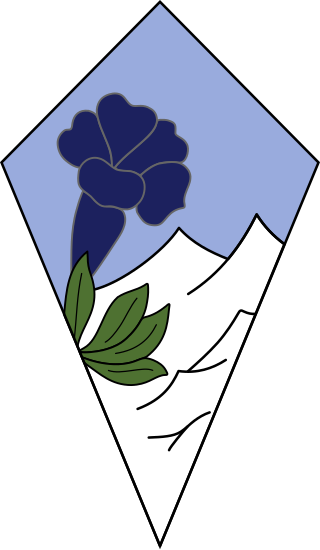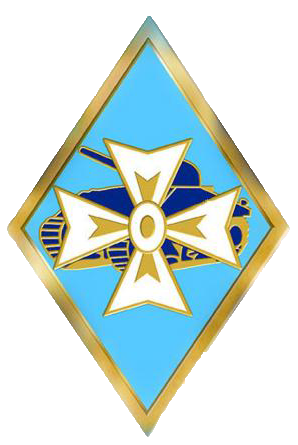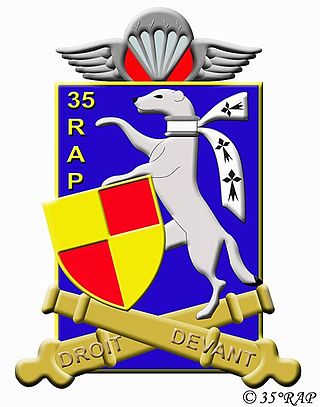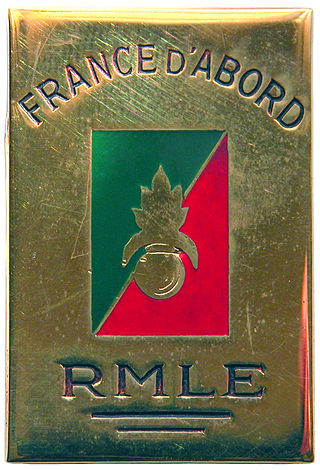
The Land Component, historically and commonly still referred to as the Belgian Army, is the land branch of the Belgian Armed Forces. The King of the Belgians is the commander in chief. The current chief of staff of the Land Component is Major-General Jean-Pol Baugnée.

The First Army was a field army of France that fought during World War I and World War II. It was also active during the Cold War.
The French 25th Motorized Division was a French Army division active during World War II.
The 1st Colonial Infantry Division was a French Army formation prior to World War I and during World War II.
The 3rd Army Corps was a corps-sized military formation of the French Army that fought during both World War I and World War II, and was active after World War II until finally being disbanded on 1 July 1998.

The 1st Marine Infantry Parachute Regiment or 1er RPIMa is a unit of the French Army Special Forces Command, therefore part of the Special Operations Command.
The 19th Army Corps was a corps of the French army. In December 1870, the Tours delegation created the 19th Army Corps which was formed in Alençon. It was recreated by decree of the JO of August 13, 1874, it brought together the various military units of Algeria. It constituted the nucleus of the Army of Africa.

The 1st Free French Division was one of the principal units of the Free French Forces (FFL) during World War II, renowned for having fought the Battle of Bir Hakeim.

The 27th Mountain Infantry Brigade is a mountain infantry formation of the French Army. The brigade is subordinated to the 1st Armored Division and specializes in mountain warfare.

The 1st Armored Division is a unit of the French Army formed during World War II that took part in the Liberation of France.

This is the order of battle for the Belgian Army at the start of the German invasion of Belgium in August 1914.

The 35th Parachute Artillery Regiment is the only airborne artillery unit of the French Army forming the air artillery component of the 11th Parachute Brigade. It is based in Tarbes together with the air cavalry, the 1st Parachute Hussar Regiment.

The 5th Dragoon Regiment is a cavalry unit of the French Army, created under the Ancien Régime in 1656 and reactivated in 2015. This regiment has a double heritage.

The 11th Marine Artillery Regiment (France) (French: 11e Régiment d'Artillerie de Marine, 11e RAMa) is an artillery regiment of the French Army. The regiment constitutes the fire support unit of the 9th Marine Infantry Brigade. The regiment employs around 950 men, fielding TRF1 155mm howitzers and MO-120-RT-61 120mm mortars. The regiment was founded in a third operational phase in 1951.

The Marching Regimentof the Foreign Legion (RMLE) was a French military unit that fought in World War I and World War II. Initially composed of marching regiments from the 1st Foreign Regiment of Sidi Bel Abbes and the 2nd Foreign Infantry Regiment of Saida, Algeria, it re-formed as the 3rd Foreign Infantry Regiment.

12th Infantry Division was an infantry division of the French Army which took part in the Napoleonic Wars, World War I and World War II. It fought at the Battle of the Nations in 1813. It was converted to a motorised infantry role at Mourmelon-le-Grand in 1939 a few days before the French declaration of war on Germany and renamed 12th Motorised Infantry Division

The 15th Infantry Division was an infantry division of the French Army originally formed after the end of the Franco-Prussian War that fought in World War I. It fought in World War II as the 15th Motorized Infantry Division, under the command of Alphonse Juin, surrendering during the Battle of France.

The 10th Infantry Division was an infantry division of the French Army which took part in the First World War, and Second World War.
57th Infantry Division was an infantry division of the French Army during the First World War. It was deployed overseas, seeing action on the Salonika front, fighting alongside British troops. It was sent to the Crimea in December 1918 as part of the Army of the Danube.














